Introduction to local SEO
Hello, and welcome to your LOCALiQ Marketing Lab course on local SEO! If you’re here, it means you want to learn more about local SEO, like:
- What local SEO is.
- How local SEO can help your business.
- Tips for successful local SEO.
- Getting started with local SEO.
- How to measure the effectiveness of your local SEO.
We hope that this course will help you feel confident in your local marketing – especially local search engine optimization, or SEO.
With that, let’s start learning!
What is local SEO?
Years ago, when people wanted to find a particular product, service, or business in their area, they would go to the Yellow Pages. Today, people have tossed aside those clunky books and turned to online searches — Yelp, Bing, Angie’s List, and, most commonly, Google and Google Maps.
Whether they’re looking for a restaurant, flower shop, or tattoo parlor, consumers want to be able to quickly find what they need, nearby. Google is revolutionizing search in that people are increasingly able to get what they’re searching for directly from the search engine results page (SERP), without even having to click through to a website.
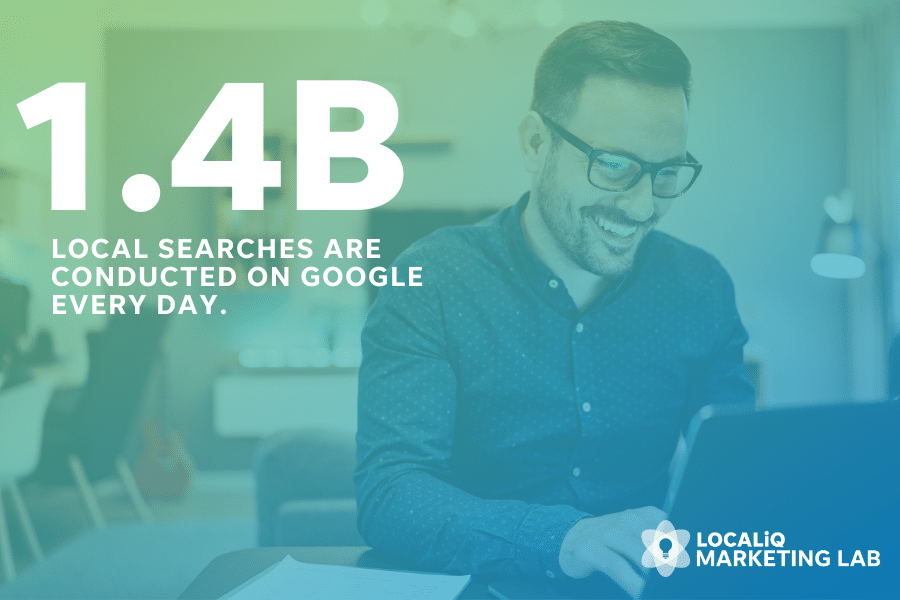
That being said, if you want to improve your online visibility and ranking on Google, you need to align your website and local listings with Google’s ways.
The term for this is local SEO.
Local SEO refers to the various tactics that will get your business website and listings to show up for location-based searches and also in the local results for broader searches (such as Google’s 3-Pack).
Why is the “local” in local SEO important?
Wait, a sec. Before we go any further, let’s clear a little something up: local SEO is a variation of SEO.
Regular non-local SEO is the type of SEO you’re probably most used to hearing about. It includes optimizing your website both in the backend and in your content for specific keywords and topics your most likely customer would search for you with. It also has to do with your site structure, load time, and mobile-friendliness.
Local SEO builds on your SEO by optimizing content, your website, and offsite ranking factors like your local listings for your location so your business shows up in local searches.
And before you ask, yes, you need both to be successful!
Why? Because you want your business to show in search results no matter the intent of searchers. With local SEO, you’re increasing your chances of appearing for searches with local intent. And with regular SEO, you’re increasing your chances of appearing for searches specific to your products and services.
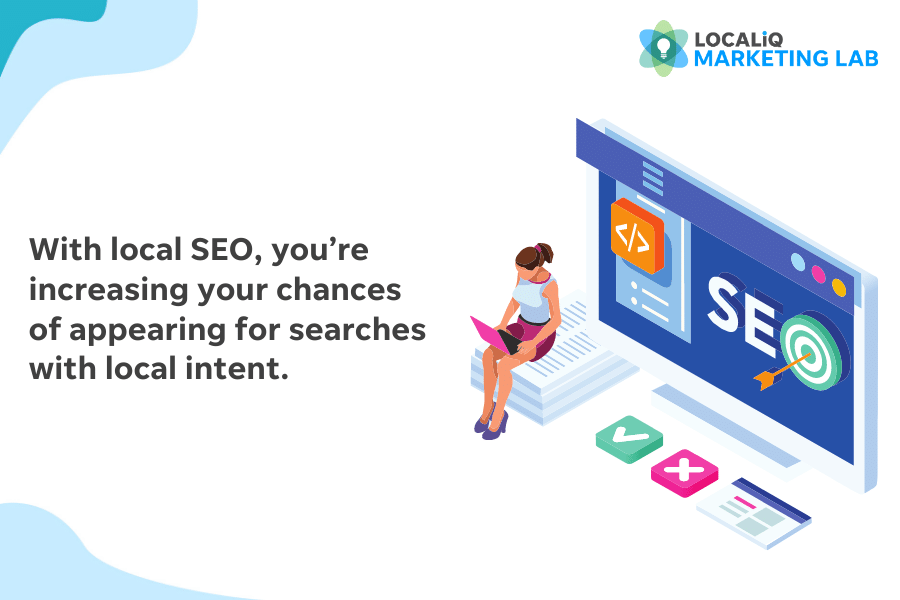
So, by employing both strategies, you’re able to cover a wider variety of searches and ensure your business has a higher chance of appearing in search results related to your business. Additionally, without a solid SEO foundation, it’s difficult for your local SEO strategy to be successful.
How can local SEO help my business?
Now that you have an understanding of what local SEO is, you’re probably wondering the specifics on how it can help your business.
Let me explain. Here are some ways local SEO can help your business.
Local SEO improves visibility
People rely on search engines to get answers to questions, learn more about products and services, and find and compare businesses. And, this isn’t just limited to new and potential customers. Existing customers are more likely to search for your business on a search engine than they are to type your URL into the address bar.
At the very least, don’t you want to make sure they can find you when they’re looking for you?
Local SEO increases website traffic
The more your business ranks on search engines for local searches, the more visitors you’ll get to your website. And organic traffic (meaning traffic that comes from search engines) can be very valuable. In fact, more than half of all web traffic comes from organic search.

Get more local SEO statistics here!
Local SEO generates qualified local leads
When your local SEO is successful, your website will show up for local customers actively looking for your products and services. That can’t be beaten!
That means that the people who are visiting your site from search engines are already interested in what you have to offer and are more likely to convert from a lead into a customer.
Local SEO is basically free advertising
Local SEO can increase awareness for your business with customers in your area. Even if a searcher doesn’t click on your website from local search results right away, you’re not losing anything – you’re not paying for an impression, and you’re not even paying for a click when they eventually do click your site. It’s free advertising on Google and beyond!
Local SEO ultimately leads to more customers
Improving your local SEO allows your business to get found online by potential customers in your area, which increases qualified traffic to your website and to your store. The more qualified traffic you’re getting, the more leads you can convert into customers.
In addition, Google search results nowadays also enable consumers to engage with businesses directly from the results pages, making engagement and conversion even more seamless.
Local SEO increases the effectiveness of your local marketing
This requires its own section. Let’s go there now.
Local SEO and your local marketing: How it works together
If you’ve completed our local marketing course, then you know that consumers need to see a brand 7-10 times before deciding to do business with them. Local SEO is a very visible place for local customers to see your brand’s information.
Also, let’s talk for a minute about the landscape of the first page of Google.
When you conduct a local search, your results probably look a little something like this:
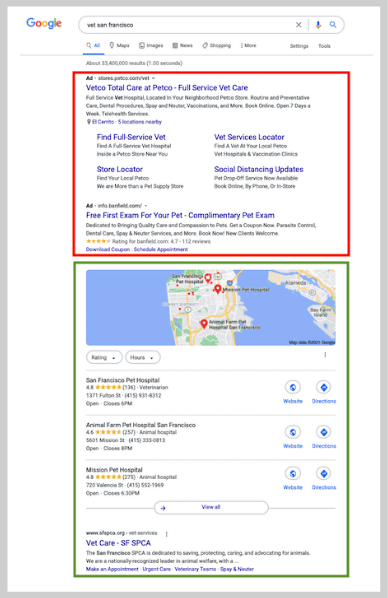
Paid search results at the top – that’s from PPC, or pay per click, which we cover in detail in this course.
Then, typically you’ll see the Google Map Pack, or the three Google My Business results that take you to Google Maps.
Then, finally, you see organic search results. This is where your website would rank with a great local SEO strategy.
So, we know that the majority of searchers don’t click on the PPC ads – but, that’s one place they’re seeing your brand’s information.
Then, they might see your business listed in the Google Map Pack.
Then! They might see your business listed in organic search results. That’s already three places in one search where a customer could see information about your business.
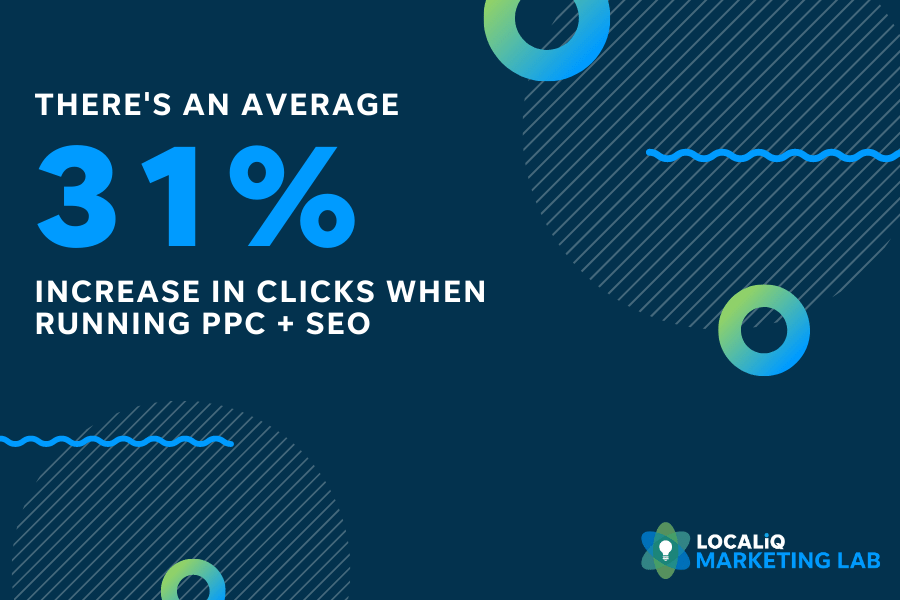
And, that’s just PPC, local listings, and SEO.
Now, what about other marketing strategies? Well, if you’re running local display advertising, a person might see your ad and conduct a search for your business. If you’re nowhere to be found, then that’s not a great sign. Same with other types of local marketing – you want to be visible when a consumer is actively searching for you, your products, or your services in your area.
Now that we all agree that local SEO is great and you need it, let’s talk about some tips to make it a success.
10 local SEO tips
Local SEO helps to increase your visibility in a way that will impact your business’s bottom line. Read on to learn how to use local SEO to:
- Achieve visibility (get your business on the map).
- Increase visibility (show up higher in local results).
- Optimize visibility (increase your appeal and engagement).
Achieve visibility on Google
Proper local SEO strategies result in more visibility on Google. In order to employ these strategies, you need to have your business set up in three main areas:
Local SEO tip #1: Focus on your Google My Business profile
Having a website is a must for local SEO, but a Google My Business listing is becoming equally – if not more – important.
Like we talked about a little earlier, the Google Map Pack appears below paid search results for most local searches. How do you show up there? By having a claimed and optimized Google My Business profile! Claim and set up your Google My Business profile to make sure you get seen in this critical place on Google–we’ll go into details on how to optimize it later.

Local SEO tip #2: Invest in a mobile-friendly website
As mobile internet usage now surpasses desktop, and as many local searches are conducted from mobile devices (think, “Chinese food near me”), Google now indexes the mobile version of a business’s website rather than the desktop.
Additionally, user experience is a major factor in ranking. If users have to pinch and zoom, face slow load times, or can’t quickly find the information they’re looking for, Google just might not show your site in local search results.
Make sure the experience of discovering, learning about, and contacting your business is as seamless on mobile as it is on desktop. Ideally, you should have a responsive website that displays and functions consistently across any device.
Local SEO tip #3: Pay attention to directory listings
As mentioned above, directory listings like Google My Business are a key component of local SEO and increasing your search visibility. Listings are virtual profiles of your business that contain key details such as the name of your business, phone number, address, website, and any other pertinent information.
In addition to Google My Business, you should get listed on other major directories such as Yelp and CitySearch. These listings will help your business to show up in smaller niche directories. The more directories your business is consistently listed under, the more visibility you’ll have online.

Increase visibility on Google
With the above SEO channels created, you are now ready to start employing local SEO tactics to get noticed on Google. These tactics involve location-based keywords, location tags, and consistency.
Local SEO tip #4: Optimize around location-based keywords
When describing your products and services, attach location-based modifiers to those keywords in your listings, social media profiles, and website pages.
You should include keywords that pertain to your industry in your website, but also to your particular location. For example, a bakery may target specific terms like “gluten-free wedding cake” but also for local searches like “Somerset county bakery” or “custom bakery downtown Somerville.”
Geographically related keywords should be placed in the titles, headers, image tags, body, and meta descriptions of your website pages in order to increase your local visibility.
For help finding local SEO keywords
Put yourself in the shoes of a potential customer in your niche. Ask yourself what their biggest priorities are, and what they would likely search for. Knowing your customer is the best way to market your business to customers. Beyond just brainstorming ideas, there are a number of online tools you can use such as Google Trends, WordStream Keyword Tool, and Answer the Public.
Related: Get step-by-step instructions for how to do local keyword research.
Google Trends
Google Trends allows you to look at the number of searches for a particular keyword over time. You can even narrow down the geographic location and length of time to get a more accurate reading.
WordStream Free Keyword Tool
The free keyword tool from WordStream allows you to discover new keywords. While it’s geared toward keywords for your local PPC strategy, you can use these keywords to benefit your local SEO as well.
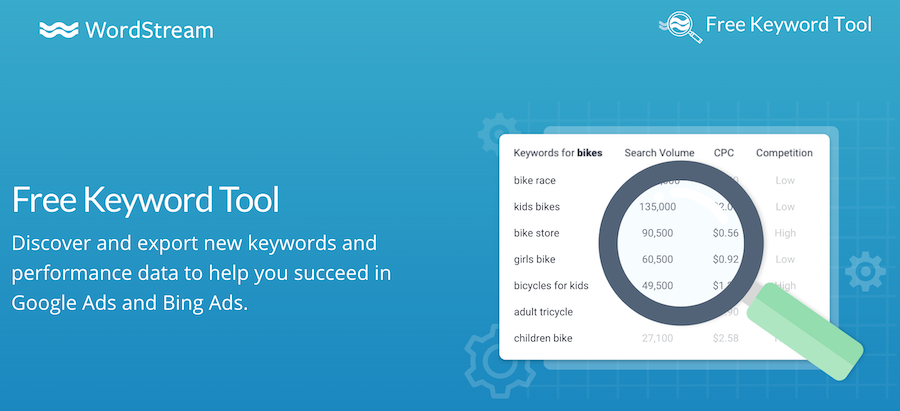
Answer the Public
Answer the Public is another free keyword research tool that generates words and phrases based on the auto-suggest results from Google and Bing.
Your local digital marketing company
When you work with a digital marketing company for your local SEO, they can identify the best location-specific keywords to optimize your content for.
Local SEO tip #5: Look into location tags
While social media does not directly impact your local SEO, taking proper measures can help send location-based signals to Google and other search engines that can strengthen your visibility.
Here are some ways to take advantage of location tags for your local SEO:
Include your address in social media profiles
Your social media profiles can show up in Google searches, and you can also potentially show up in local searches directly within top social media sites like Facebook and Instagram. Just make sure all the location-based fields in your social media profiles are filled out.
Create a location on Facebook
Create a location for your business so that you — and your followers — can tag your business in Facebook and Instagram posts. This will amplify your visibility through your followers’ networks.
Use location-based hashtags
Another way people can perform location-based searches online is through hashtags. A person looking for a tasty late-morning meal can easily find a nearby spot by searching #bestbrunchboston on Instagram. Once again, social media doesn’t directly impact your local SEO, but it does send local signals to Google that may strengthen your local visibility.
Local SEO tip #6: Don’t forget schema markup
Schema markup communicates a certain set of data to search engines like Google and Bing so they can show up on search engines with rich snippets. Rich snippets provide more information than the general local search result, which leads to a higher click-through rate.
Here’s an example of a rich snippet. You can see more information than the general search result, including a rating, calorie information, and time to cook.

Here’s an example of a general search result for reference:

By adding schema markup to specific pages on your website, you can increase your chances of having rich snippets appear and hopefully drive more local visitors to your website.
Local SEO tip #7: Consistency is key
It’s not enough to just get set up in online directories and social media profiles. Taking the time to ensure consistency across all of your online entities can mean the difference between showing up first in search results…or last.
Why? Because consistency is a Google ranking factor. Google is obviously not a person – even though it may feel like it is – so Google doesn’t know the facts about your business. Search engines use signals from across the web to determine how trustworthy the information they’re showing is about your business. So, if your business name, phone number, and address vary across different sources on the web, they won’t have a high level of trust in the information and may not show it.
This is why managing your local listings is so important.
For example, you wouldn’t want to use the title “Sweet Shoppe” on Yelp and “The Sweet Shoppe” on your Google My Business listing. You want your business name, address, and phone number (also known as NAP!) to be consistent across all sources online.
Optimize your local visibility
Now that you’ve established some best practices for local search marketing, it’s time to build on that foundation to optimize your local visibility.
Local SEO tip #8: Geographically modify your business name
In most cases, your business name will be unique enough to stand apart from other businesses. However, if your restaurant is named “Mickey’s,” you may find yourself competing with a plethora of other “Mickey’s” out there.
You might want to list your restaurant in databases and on your website as “Mickey’s Irish Pub Chicago.” Not only will this differentiate your business, but it will also make you more visible for searches like “Irish Pubs in Chicago.” Once again, make sure that if this is the name you choose, you use it across all platforms.
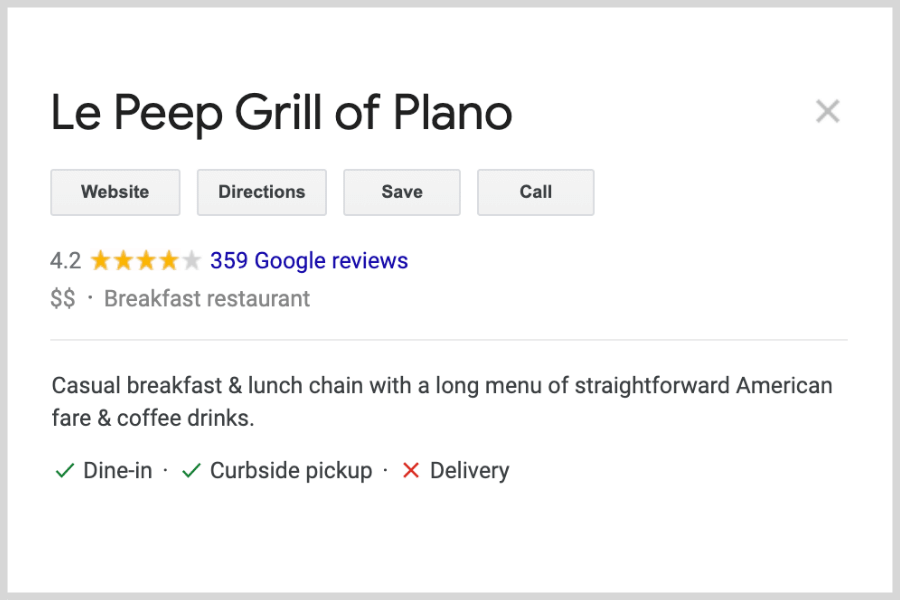
Local SEO tip #9: Publish locally relevant content
Authentic content related to your industry is foundational to SEO of any kind. For local businesses, however, locally relevant content should also be part of your content marketing strategy. For example, if you’re a locksmith in Sacramento, you could write a blog post entitled “5 Ways to Keep Your Home Safe in Sacramento,” or Yoga professionals could publish a post such as “Top 10 Natural Food Stores in the Bay Area.”
Also, you should include information about local events and area partnerships, as this will help to draw in local users and enhance your local visibility.
Local SEO tip #10: Get reviews to boost local search rankings
Google understands that to be most useful to its users, it needs to give them accurate information they can rely on to choose which business to engage with. The more customer reviews you have (ideally, positive reviews), the more visible you’ll become in search results and feeds.
A good reputation can also help you show up for local searches that include “best.” Google shows businesses with a star rating of 4.5 or above in the Map Pack for “best of” searches, so work to get your reputation in tip-top shape to increase your chances of showing for those local searches.
How to measure local SEO success
You now have a great understanding of local SEO best practices that will help your business show up in local searches and – hopefully – get more local searchers to click through to your site and become paying customers!
But, once you’ve executed some of these strategies, it’s time to determine if they’re working to drive results. This can be tricky for many people because SEO can be difficult to measure directly.
Here are five key metrics to pay attention to in order to determine local SEO success.

Local SEO metric #1: Organic traffic
Organic traffic is the number of people who are visiting your website by clicking from the search results. You want to see this number increase over time because it signals that your site is showing up in search results for relevant searches – many of them likely local searches.
You can find this information through Google Analytics or with any website tracking you may be using through your digital marketing partner or a third-party provider.
Local SEO metric #2: Bounce rate
While bounce rate isn’t directly tied to local SEO, it’s still important to measure because it lets you know if the content on your website is valuable for users.
Bounce rate shows the percentage of users who visit your website and leave without clicking through to another page.
For example, if you click to a local mechanic’s website from Google but realize they specialize in brake repair and you’re looking for a place to get your oil changed, you’ll probably hit the back arrow to continue looking at results on Google. This would be a bounce. But, if you clicked to that mechanic’s site and saw they offered oil changes, you might click on that service to learn more or to get pricing information.
A high bounce rate doesn’t necessarily mean your local SEO is ineffective, but it is something to watch so you can determine if there are ways to improve your SEO or site structure to encourage users to click through to more pages on your site.
Local SEO metric #3: Google My Business profile metrics
Your Google My Business profile is an important local SEO tool that can give you some good insight into how you’re showing up for local searches.
Within your Google My Business dashboard, you get a lot of access to information and reporting on how and when your listing is being seen like:
- Queries, which shows the most popular searches for your business.
- How customers search for your business, which shows whether they searched for your business name, a related business, or a keyword.
- Where customers are seeing your listing, either on Maps or Search.
- Photo views, which tell you how many times your pictures were seen.

Additionally, you can see the number of people who called, visited your website, or clicked for directions to your business directly from your listing.
You can optimize your Google My Business listing to help improve your performance here.
Local SEO metric #4: Leads
If you have a way to track your leads, then you can determine which leads are coming from organic search results. As your local SEO strategy continues building on itself, see if the amount of leads you get from organic search results grows. This can confirm whether or not your local SEO strategy is resonating with searchers.
If you notice that you’re not receiving more leads from your local SEO strategy, you may want to look into your website structure and ensure you have an effective way to collect leads on your website.
Local SEO metric #5: Location-based keyword performance
Keywords aren’t the most important local SEO metric, but they can give you an idea of how searchers are finding you and determine whether or not your site is aligning with search terms that would be beneficial for your business.
Maybe you notice that you’re not ranking for any local search terms around teeth cleaning Denver and that’s something you want to see grow – you can optimize your local SEO for that keyword to help boost your performance.
Understanding how your local SEO is performing is important for your strategy. Using these local SEO metrics as a starting point, you can watch your results grow as your continue investing in a local SEO strategy.
Congratulations, local SEO expert!
You did it–you learned all about local SEO and what goes into a successful strategy that helps you get found for local searches.
If you haven’t already, now would be a great time for you to learn about one of the other ways to show up for local search results: local PPC.